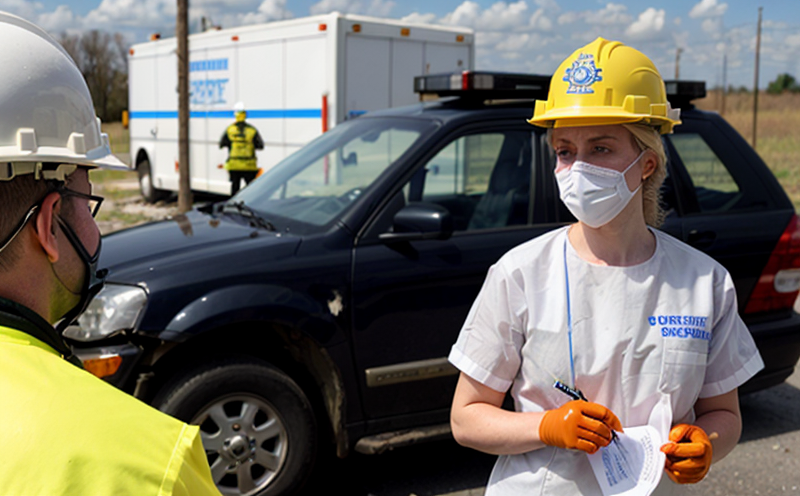ASTM E1708 Safety Instrument Testing for Accident Monitoring
The ASTM E1708 standard is a critical tool in ensuring safety and compliance for organizations dealing with radiation and nuclear testing, specifically focusing on the evaluation of safety instruments used to monitor accidents. This service ensures that these devices are capable of providing accurate readings during emergencies, which can be life-saving. The ASTM E1708 procedure involves subjecting safety instruments to a series of tests designed to simulate real-world accident scenarios. These tests are crucial for ensuring that the instrument functions reliably and accurately under challenging conditions.
The testing process begins with thorough preparation of the specimen, which includes calibration against known radiation sources to ensure accuracy. The specimens are then subjected to various accident scenarios defined by the ASTM E1708 standard, including exposure to different levels and types of ionizing radiation. This ensures that the instruments can provide accurate readings under a wide range of conditions.
The results from these tests are used to assess the instrument's compliance with international standards such as ISO 14925 and ASTM E1708 itself. Compliance is essential for ensuring that the devices meet regulatory requirements and can be trusted in critical situations. The service also includes a detailed report that outlines the test parameters, specimen preparation, instrumentation used, and results obtained.
For quality managers, compliance officers, R&D engineers, and procurement professionals, this testing ensures that safety instruments are reliable and accurate, which is crucial for protecting personnel and assets during accidents. By adhering to ASTM E1708 standards, organizations can demonstrate their commitment to safety and comply with regulatory requirements.
The testing process involves several key steps:
- Calibration of the specimen against known radiation sources
- Exposure of the specimen to various accident scenarios defined by ASTM E1708
- Evaluation of the instrument's performance under these conditions
- Compliance assessment with relevant international standards
- Preparation and submission of a detailed report
The ASTM E1708 testing process is designed to simulate real-world accident scenarios, making it an invaluable tool for ensuring safety instrument reliability. By adhering to this standard, organizations can ensure that their instruments are capable of providing accurate readings under challenging conditions.
Industry Applications
The ASTM E1708 Safety Instrument Testing for Accident Monitoring is widely used in various sectors where radiation safety is paramount. This includes nuclear power plants, research facilities, and medical institutions dealing with radioactive materials. The testing ensures that the instruments used to monitor accidents are reliable and accurate.
| Industry | Application |
|---|---|
| Nuclear Power Plants | Testing of safety devices for reactor containment integrity during accidents |
| Research Facilities | Evaluation of radiation monitoring systems in high-risk environments |
| Medical Institutions | Assessment of dosimeters used in radiation therapy and diagnosis |
The ASTM E1708 standard is also applicable to other sectors where ionizing radiation safety is a concern, such as industrial radiography and radiotherapy. By ensuring that the instruments meet this standard, organizations can demonstrate their commitment to safety and compliance.
Quality and Reliability Assurance
To ensure the reliability and accuracy of testing conducted under ASTM E1708, several quality assurance measures are implemented. These include strict adherence to international standards such as ISO 9001 for quality management systems and ISO/IEC 17025 for laboratory accreditation.
- Calibration of instruments against known radiation sources
- Use of standard test specimens with defined characteristics
- Detailed record-keeping of all testing processes
- Regular calibration and maintenance of equipment
- Peer review of results by qualified personnel
- Continuous improvement based on feedback and analysis
The use of these quality assurance measures ensures that the testing conducted is accurate, reliable, and consistent with international standards. This is crucial for ensuring that the instruments meet regulatory requirements and can be trusted in critical situations.
International Acceptance and Recognition
The ASTM E1708 Safety Instrument Testing for Accident Monitoring has gained widespread recognition and acceptance across various countries due to its stringent testing procedures and adherence to international standards. The United States, Canada, Europe, Japan, and other regions have adopted this standard as a benchmark for safety instrument reliability.
Organizations that undergo ASTM E1708 testing can demonstrate their commitment to safety and compliance with regulatory requirements. This is particularly important in sectors where radiation safety is a critical concern. By adhering to this standard, organizations can ensure that their instruments are capable of providing accurate readings under challenging conditions.





